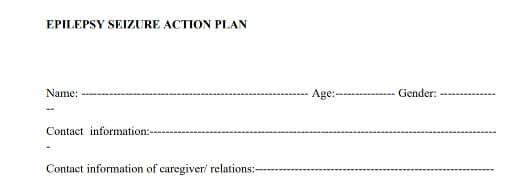Every patient with epilepsy should have an epilepsy action plan (seizure action plan) which is to be shared with friends, family, coworkers or teachers (for school children).it should also be kept in strategic places where it can be seen easily and implemented.

A seizure action plan is a detail of necessary information that is required to respond appropriately to a seizure. It is very important for people with epilepsy who have refractory or poorly controlled seizures.
Seizures have significant impact on the daily life of people living with epilepsy. There is the loss of independence, lack of predictability, potential injury, possible mortality, stigmatization due to lack of education of people around the individual with epilepsy either at school, work or in the home. There is also the lack of knowledge on when to escalate care on the part of the caregiver, teachers or coworkers.
A seizure action plan offers predictability for an unpredictable condition. It helps caregivers to provide the fullest possible management of epilepsy. It answers key questions like what to do, where to go and when to go to the hospital if a seizure occurs.
Goals of the epilepsy action plan
The goals of a seizure action plan include the following:
- To reduce the likelihood of status epilepticus
- To reduce the morbidity and mortality associated with seizures
- To preserve independence
- To circumvent seizure emergencies
Important steps in the development of a seizure action plan
- identify what is a seizure
- identify the seizure type and its description
- track and count seizures to establish a baseline
- follow the progression of the number of seizures and types of seizures.
Components of a seizure action plan
- Name and contact information
- Doctor and hospital contact information
- Birthdate
- Diagnosis
- Date of creation of the plan
- Drug allergies
- List of present antiepileptic medications and dosages
- Seizure type (frequency, description)
- Seizure pattern (duration of seizure: what is considered normal or abnormal for the individual)
- Rescue therapy and how to deliver it.
- Maximum doses of rescue therapy medication that may be given at a time e.g rectal diazepam, nasal diazepam and midazolam nasal spray.
- When to call emergency services or take the person to the hospital
[download_after_email id=”5687″]
Generally, most seizures will abort spontaneously in 1-3 minutes. However, if it lasts more than 5 minutes, rescue therapy should commence. If seizure takes an abnormal pattern for example repeated seizures that place an individual at risk of injury, greater than one seizure type outside the normal pattern for the individual, seizure clusters or status epilepticus, then rescue therapy should be started immediately. Rescue therapies can also be used in any type of seizure with aura just before the motor seizure onset, in those with focal aware seizures whose seizures are impactful on their daily lives and in women with catamenial epilepsy.
Seizure clusters are defined as 2 or more seizures in 6 hours or greater than 2 seizure episodes in 24 hours. An individual is said to have a seizure cluster if seizures occur more frequently than the normal baseline pattern within 24 hours with regain of full consciousness in between episodes of the seizures. seizure clusters can lead to status epilepticus.
Status epilepticus is the occurrence of two or more seizures without regain of consciousness in between episodes or seizures lasting greater than five minutes.
It is important to keep a seizure diary in order to identify a pattern, identify possible triggers and avoid them and also for record purposes. A seizure diary aids identification of a drug-responsive and drug-resistant or refractory seizure. You should always attend your hospital follow-up appointments with your up to date seizure diary. It will help your doctor when deciding an alternative line of management for your epilepsy if need be. Your follow-up visit is the time to tell your doctor about your concerns, complaints or possible side effects of the antiepileptic drug you are taking. Therefore, ensure you do not miss your follow up appointments.
[download_after_email id=”5686″]
